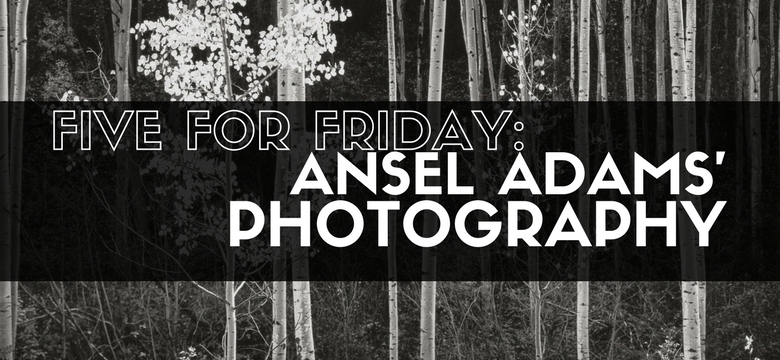This week’s Five for Friday looks at a quintet of offerings from Ansel Adams, who is considered one of the greatest landscape photographers who ever lived, that will be among the images available May 18 in Heritage Auctions’ Photographs Auction in New York.
Buy, Value or Appraise Your Fine Art – Paintings, Drawings, Sculptures
Bid or buy art for sale, value your item, or request a free appraisal to sell your collection.
What Was Ansel Adams Famous For?
Known for shooting black-and-white images almost exclusively, Adams usually used large-format cameras because they offered a high enough resolution to capture enough detail to create clear crisp images, even when shooting large landscapes. Adams was so adept at capturing nature’s beauty that in 1985, a forest and a mountain were renamed after him.
1. Dogwood, rain, Tenaya Creek, Yosemite Valley, California, circa 1955
Adams and fellow photographer Fred Archer collaborated to develop the “Zone System,” which “provides photographers with a systematic method of precisely defining the relationship between the way they visualize the photographic subject and the final results.” The extraordinary clarity – including in shadowed areas – that the system allows is evident in this image, from the ripples in the water to the ridges and dimples in the rocks and tree bark, the small blossoms on branches and the texture of the mountain slope in the background.
2. Aspens, Northern New Mexico, 1958
Adams’ 1958 Aspens, Northern New Mexico (est. $20,000-30,000) reveals another Adams trademark: an extraordinarily stark contrast between the foreground and the background. Many aspen trees, just like several varieties of birch trees, have an outer layer of bark that can range between a light silver to white. In this image, Adams captures the light on the light aspens in the foreground, allowing them to virtually jump out at the viewer because of the dark trees and plants in the background.
3. Tree, Stump and Mist, Northern Cascades, Washington, from Portfolio VII, 1958
Another piece in the auction – Tree, Stump and Mist, Northern Cascades, Washington, circa 1958 (est. $7,000-10,000) – also makes use of the dramatic contrast between the foreground and the background. In this image, a large stump, covered with dirt and small plants, is dark and dramatic, while the background features trees shrouded in such thick fog that they partially disappear into the mist. While many photographers would focus on a complete tree, Adams focuses instead on the stump, underscoring his non-traditional way of viewing the world around him.
4. Moonrise, Hernandez, New Mexico, 1941
In Moonrise, Hernandez, New Mexico, 1941 (est. $3,000-5,000), Adams eschews the foreground-background contrast, instead playing light images on the ground – and including clouds and the moon – against a black sky that occupies well over half of the image. Adding to the dramatic contrast is the mountains in the background. The snowcaps almost melt into the clouds above, setting off the dark parts of the mountain underneath. Other than the clouds, the light highlights are a few buildings and the gravestones in a cemetery in the foreground, surrounded by sagebrush tinged with light.
5. Jeffrey Pine, Sentinel Dome, Yosemite National Park, 1940
In the first four images, Adams plays on the contrast between adjacent images, either side-by-side, in foreground and background, or above and below. Jeffrey Pine, Sentinel Dome, Yosemite National Park, 1940 (est. $3,000-5,000) is different because it showcases contrast between an object – in this case, a curved, arching tree – and its own shadow. The way the photo is composed, the tree curls up along the left side and then swoops over the top of the image. The sun shines down from the upper left, virtually washing the far left edge of the tree into the sky. What jumps out of this image, though, is the shadow, instead of the tree itself. The inside (right) edge of the tree and overhanging branches are darkened by shadow, as are the rocks and ground below. The photo is signed in ink by Adams in the margin.
These, and other extraordinary images are available to collectors and photography lovers alike May 18 in Heritage Auctions Photographs Auction.
